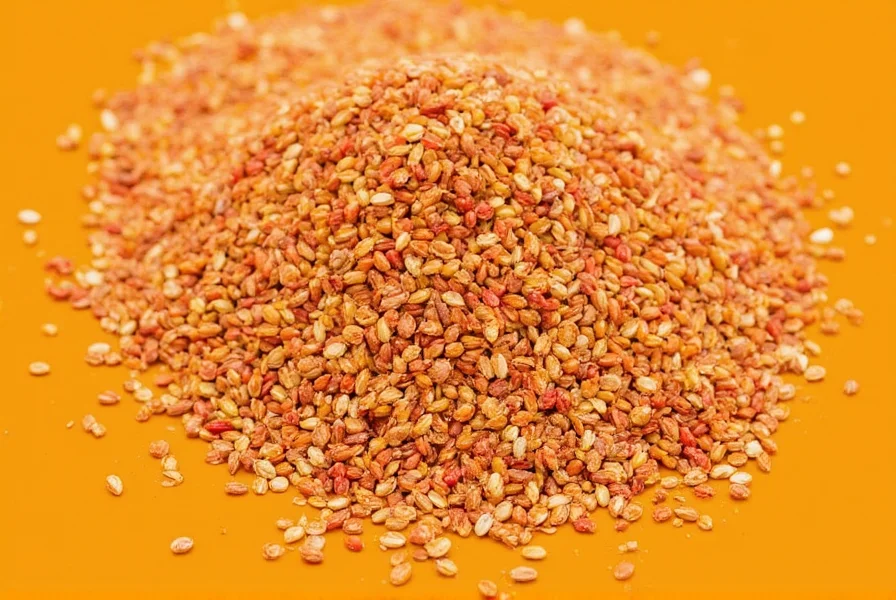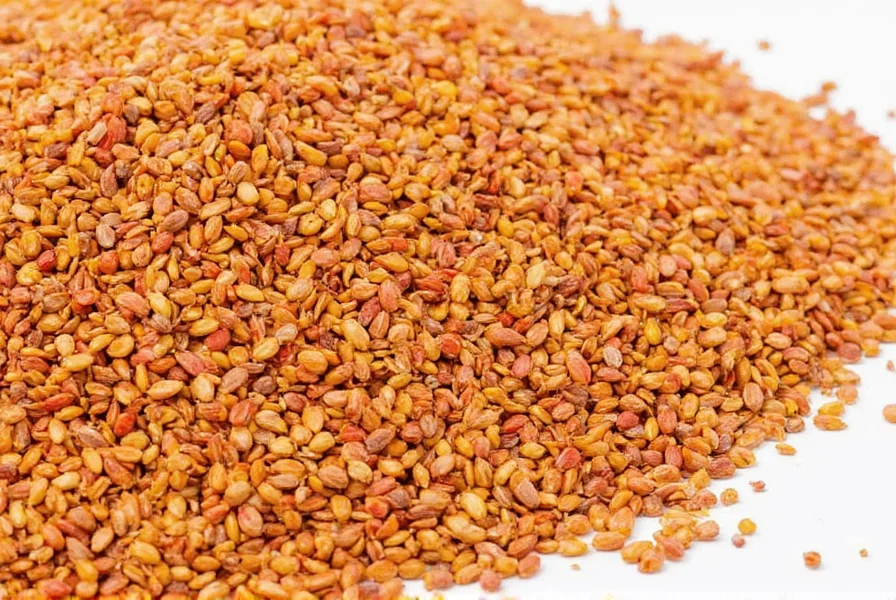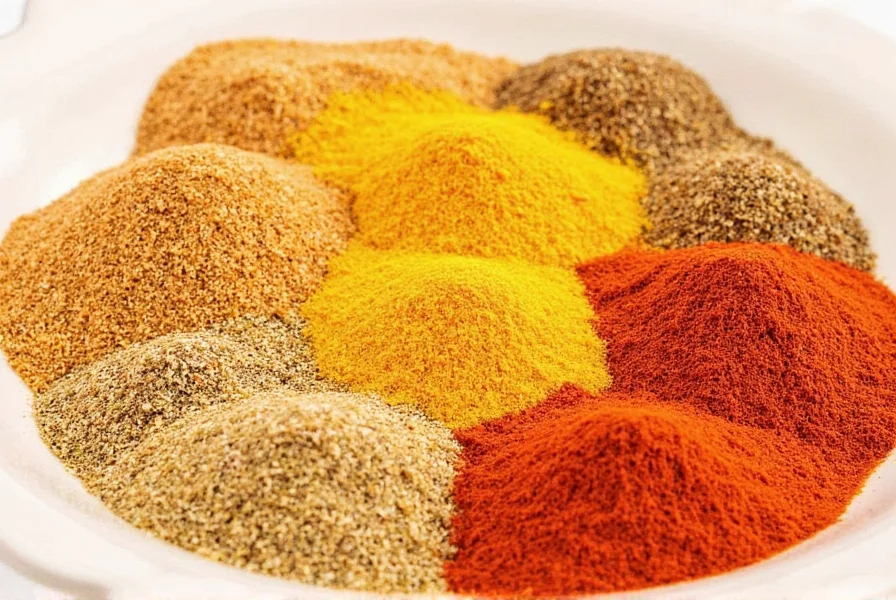Running out of annatto seeds? Here are the top 7 substitutes you can use right now for paella, rice, stews, and more — with color and flavor comparisons to save your recipe!
Annatto seeds (achiote) are a staple in Latin and Caribbean cooking for their signature golden-orange hue and mild earthy flavor. But if you don't have them, these pantry staples can step in seamlessly.
| Substitute | Color Impact | Flavor Profile | Ease of Use | Best For |
|---|---|---|---|---|
| Paprika | Moderate orange-red | Mildly sweet, smoky | ⭐⭐⭐⭐☆ | Rice dishes, stews, marinades |
| Saffron | Golden yellow | Delicate, floral, luxurious | ⭐⭐☆☆☆ | Fancy rice dishes, seafood |
| Turmeric | Bright yellow-orange | Earthy, slightly bitter | ⭐⭐⭐⭐☆ | Curries, soups, sauces |
| Red Bell Pepper Powder | Reddish-orange | Mildly sweet, vegetable-like | ⭐⭐⭐☆☆ | Veggie dishes, pasta, roasted veggies |
| Chili Powder | Reddish-orange | Spicy, cumin-heavy | ⭐⭐⭐⭐☆ | Southwestern, Tex-Mex cuisine |
| Beetroot Powder | Burgundy-red | Earthy, sweet | ⭐⭐☆☆☆ | Smoothies, baked goods, plant-based dishes |
| Tomato Paste | Deep red-orange | Umami-rich, tangy | ⭐⭐⭐⭐☆ | Stews, braises, meat sauces |
1. Paprika – The Versatile Classic for Rice and Stews
Paprika is the top choice for replacing annatto in most recipes, especially when you need a similar orange-red hue for dishes like paella or Mexican rice. Its mild, smoky flavor blends perfectly without overpowering other ingredients.
- Pro tip: Toast it lightly in oil before adding liquids to enhance its color and aroma for perfect paella or stews.
- Best for: Rice dishes, stews, and meat marinades where you need reliable color and subtle flavor.
2. Saffron – The Luxurious Alternative for Seafood Paella
For elegant dishes like seafood paella or French bouillabaisse, saffron delivers a delicate golden color and floral notes that elevate the dish. It's the premium substitute when budget allows.
- Pro tip: Soak saffron threads in warm broth for 15-30 minutes before adding to paella for maximum color release.
- Best for: Fancy rice dishes, seafood, and creamy sauces where luxury and aroma matter.
3. Turmeric – The Bold Choice for Curries and Vegan Dishes
Turmeric provides intense yellow-orange color and earthy flavor, making it ideal for Indian curries or vegan "cheese" sauces. Use sparingly to avoid bitterness.
- Pro tip: Combine with cumin and coriander to balance its strong flavor in vegan curry recipes.
- Best for: Indian curries, lentil soups, and plant-based dishes needing vibrant color.
4. Red Bell Pepper Powder – The Natural Option for Roasted Veggies
This sweet, vegetable-like powder gives a beautiful reddish-orange tint without heat, perfect for roasted vegetables or pasta sauces where you want natural color.
- Pro tip: Add early in cooking to allow flavors to develop fully in roasted veggie dishes.
- Best for: Veggie dishes, pasta, and roasted vegetables for a subtle, sweet hue.
5. Chili Powder – For a Kick in Tex-Mex Recipes

Chili powder (especially cumin-based blends) adds both color and heat, making it perfect for Tex-Mex tacos or chili con carne where you want extra spice.
- Pro tip: Mix with tomato paste and oil for richer color and depth in enchilada sauces.
- Best for: Tex-Mex tacos, enchiladas, and chili con carne with a spicy twist.
6. Beetroot Powder – For Sweetness in Smoothies and Baked Goods
Though not an exact match, beetroot powder delivers a rich burgundy-red color and natural sweetness, ideal for smoothies or plant-based desserts where color is key.
- Pro tip: Blend with tahini or avocado for even distribution in raw dips and dressings.
- Best for: Smoothies, cakes, and plant-based dishes needing a vibrant red hue.
7. Tomato Paste – The Umami Boost for Braised Meats

Tomato paste adds deep red-orange color and savory umami, making it perfect for hearty beef stews or tomato-based sauces where richness matters.
- Pro tip: Cook slowly in oil for 5-10 minutes to deepen color and flavor in braised meats.
- Best for: Braised meats, hearty soups, and tomato-based stews needing rich texture.
How to Use Annatto Seed Substitutes Like a Pro
Master these techniques for perfect results with any substitute:
- Toast spices: For paprika, turmeric, or red bell pepper powder, toast briefly in oil to unlock maximum color and aroma for rice dishes.
- Soak saffron: Always soak saffron threads in warm liquid before adding to paella or risotto for optimal color release.
- Blend for even distribution: Mix beetroot powder or turmeric with yogurt or cream to avoid clumps in sauces and dressings.
- Add gradually: Start with 1/2 teaspoon of potent spices like turmeric in curry recipes and adjust to taste.
- Pair wisely: Combine paprika with cumin for authentic Tex-Mex flavor or saffron with cinnamon for complex paella notes.
Buying Guide: Choosing the Right Substitute for Your Dish
Select substitutes based on your specific recipe needs:
Key Considerations
- Flavor compatibility: Does the substitute complement other ingredients? (e.g., paprika for Spanish dishes, saffron for seafood)
- Color impact: Need golden yellow (saffron), bright orange (turmeric), or deep red (tomato paste)?
- Dietary preferences: Plant-based? Use beetroot powder or red bell pepper powder for vegan options.
- Cooking method: For dry rubs, use ground spices; for wet applications, use infused oils or pastes.
Recommended Products and Brands
- McCormick Smoked Paprika: Rich, smoky flavor perfect for Spanish rice and stews.
- Olde Thompson Organic Turmeric: High-quality, finely ground powder ideal for vibrant curry color.
- Kalustyan's Saffron Threads: Premium quality for authentic paella and seafood dishes.
- Simply Organic Red Bell Pepper Powder: Sweet, vibrant, and additive-free for roasted vegetables.
- La Costeña Chile Guajillo Powder: Earthy and moderately spicy for authentic Mexican recipes.
| Use Case | Recommended Substitute |
|---|---|
| Traditional Latin dishes | Paprika or chili powder |
| Fancy seafood paella | Saffron |
| Vegetarian curry | Turmeric + cumin |
| Roasted vegetables | Red bell pepper powder |
| Hearty beef stew | Tomato paste + paprika |
| Plant-based cheese sauce | Turmeric + nutritional yeast |
| Raw dips or dressings | Beetroot powder (mixed with tahini or avocado) |
Frequently Asked Questions About Annatto Seeds
Is annatto a common allergen?
While rare, annatto can cause allergic reactions in sensitive individuals. Symptoms may include hives, stomach cramps, or respiratory issues. If you suspect an allergy, consult with a healthcare provider before consuming.
How much substitute should I use for annatto seeds?
As a general rule, use ½ teaspoon of ground substitute for every 1 teaspoon of annatto seeds called for in your recipe. For whole seeds, substitute 1 teaspoon of ground spice for every 6-8 whole seeds. Always start with less and adjust to taste and color.
Can I replace annatto with paprika in all recipes?
Mostly yes, though paprika has a milder flavor and may not provide the same earthiness. Adjust other seasonings accordingly. For best results in Latin dishes, use smoked paprika to mimic annatto's distinctive profile.
Are annatto seeds and achiote the same thing?
Yes! Achiote is the Spanish name for annatto seeds. Both refer to the same ingredient used widely in Latin American and Caribbean cuisines.
Where can I buy annatto seeds?
Look in Latin American markets, online spice retailers, or stores that carry international ingredients like Whole Foods or Penzey's. They're often sold as whole seeds, ground powder, or pre-made annatto oil.
Can I make my own annatto oil with substitutes?
Absolutely! Use any substitute and infuse it in oil with garlic and herbs. For paprika or turmeric, heat 1-2 tablespoons of spice in 1 cup of oil over low heat for 10-15 minutes, then strain for homemade annatto oil.
Do annatto substitutes work the same in liquid vs. dry applications?
No, the behavior differs. In wet applications like stews, use oil-based infusions or powdered substitutes. For dry rubs or seasoning mixes, ground spices work better. Saffron and turmeric release color more effectively in liquid environments, while paprika works well in both contexts.
How long do annatto substitutes keep in my pantry?
Ground spices like paprika and turmeric stay fresh for 1-2 years when stored in airtight containers away from light. Saffron retains quality for 2-3 years. Tomato paste (once opened) should be used within 2 weeks. Beetroot powder keeps for about 1 year. Always check for color fading or loss of aroma to determine freshness.
Can I combine multiple substitutes for better results?
Yes! Many professional cooks blend substitutes to achieve the perfect balance. Try combining paprika with a pinch of turmeric for enhanced color in rice dishes, or mix red bell pepper powder with a touch of tomato paste for richer flavor in stews.
Will the substitute change the texture of my dish?
Generally not with powdered substitutes. However, tomato paste will thicken sauces slightly, and beetroot powder can add subtle earthiness to textures. If using whole substitutes like saffron threads, remember to remove them before serving unless they're meant to be eaten (like in some rice dishes).
Final Thoughts: Spice Up Your Kitchen with Confidence
Running out of annatto seeds doesn't mean you have to cancel your recipe — it means it's time to experiment with flavor and creativity. From pantry-friendly paprika to luxury saffron, you now have a toolkit of substitutes that will help you save the day (or night!) in the kitchen.

Whether you're a home cook experimenting for fun or a pro chef fine-tuning a menu, knowing your spice substitutes is a superpower. Now go forth, spice up your meals, and enjoy the vibrant world of flavors that await you!










 浙公网安备
33010002000092号
浙公网安备
33010002000092号 浙B2-20120091-4
浙B2-20120091-4